How to Choose the Flooring for your Patio
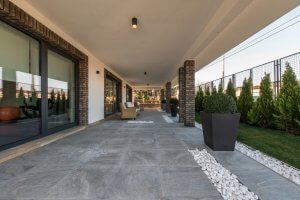
If you want to renovate your outside living area to be ready for when summer arrives, apart from furniture you should start with the floors. Would you like to know how to choose the flooring for your patio? Well, keep reading… you’ll find some interesting and useful suggestions.
What kind of flooring for your patio do you need?
To answer that question, you should have in mind some important things. For example, what you will use the space for, who you live with, how much money you want to spend, etc. But in general terms, the flooring you choose for your patio should be long-lasting, stylish, and easy to maintain. Among the many options, here are some ideas.
1. Timber flooring for your patio
Having a timber floor is a winner, no matter whether it’s indoors or outdoors. But, in the case of an outdoor timber floor, it’s crucial to pay attention to the timber treatment.
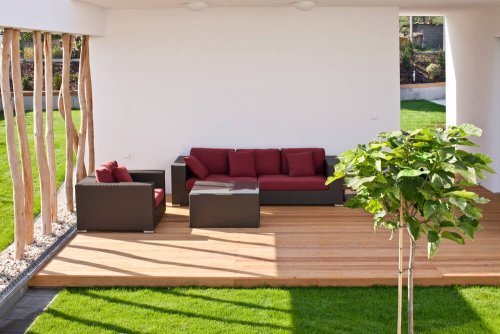
If the timber is treated correctly, it will last much longer. You’ll also avoid moisture problems or issues with mold, and it will always look great. We recommend that you still apply a special protector twice a year.
Among the most common options in timber for patios you can find:
- Pine (more economical, with different textures and tones)
- Tropical timber (more resistant and long-lasting)
- Synthetic (doesn’t rot, is easy to clean, non-slip, it doesn’t swell and is impervious to the elements).
2. Tiled flooring for your patio
This is really one of the most common materials for patios and decks, due to the fact that it is very long lasting and doesn’t need maintenance. Tiles will endure the rain, sun, and changes in temperature without any problems. It’s ideal if you don’t have time to care for it!
Among the options we recommend are stoneware tiles, which absorb the least amount of water and don’t get damaged over time. You can tell which tile it is because the back side of the tile is white. We also recommend that you take note of the thickness of each tile you are considering, because this will determine how hard it is, and how long it will last.
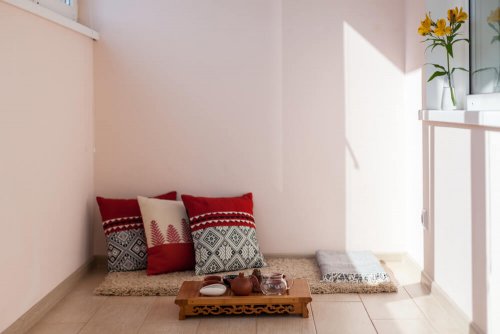
Over the last few years, new materials in tiles have come out, including in tiles for patios. These imitate timber, stone or other textures. They are available in various colors and designs, and even with more or less textured or rough surfaces. They are perfect to combine with your outdoor decor and furniture!
3. Natural stone flooring for your patio
Another option that is really pretty, but aside from the aesthetic aspect, it’s ideal for outdoors due to its capacity to stay the same despite changes in climate. It doesn’t matter if it’s hot or cold, if it rains or if it’s sunny or if there is snow on the ground. Natural stone floors will stay as they were the very first day you installed them.
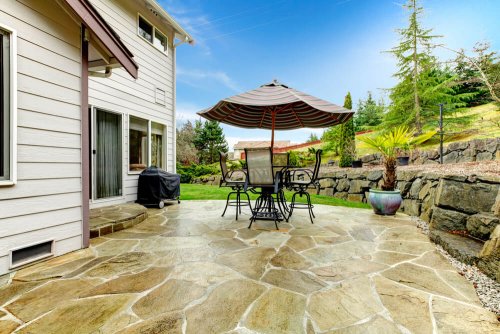
You could go for rough or smooth finishes, diverse colors and more or less impenetrability
We suggest that you use slate floors for areas close to the pool or to other water sources.
4. Artificial grass for your patio
For a place of leisure and entertainment, if you have children or pets, artificial grass can be an excellent choice. This type of material has many advantages. For example, installing it is very simple, maintenance is almost non-existent, it’s rain resistant, is anti-allergenic, and is certainly more economical to purchase and care for than natural grass.
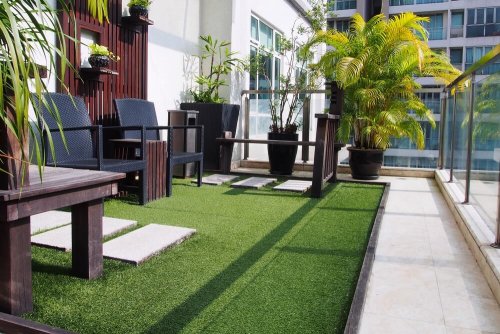
You can choose artificial grass of any length. It’s not necessary to mow or water it, you can walk barefoot without fear of hurting your feet, and even when it’s very sunny it never goes yellow. It will also give a nice touch to your home if you live in the city. A marvelous contrast!
5. Composite flooring for your patio
This is the latest in outdoor flooring. Composite is made by combining synthetic resins or glues with wood fibers. This type of floor is very resistant and long-lasting, endures humidity, and doesn’t need much maintenance. It’s also easily laid because it comes in panels and doesn’t get corroded with chemical products such as cleaning products or disinfectants.
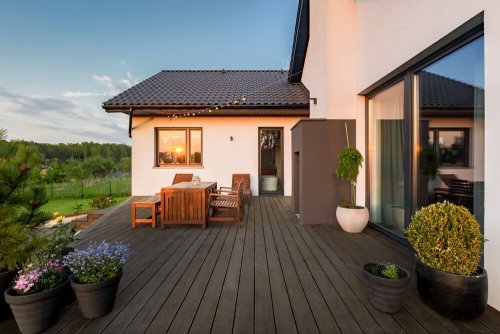
Composite flooring is chosen many times for beside the pool because it’s non-slip and reduces to the minimum any risks associated with wet zones. You can let your kids play on it without fear of them slipping and hitting their head. Also, its color doesn’t fade if it comes in contact with chlorine.
Of course, you don’t just have to choose one type of flooring for your patio… you can combine various materials according to your needs. For example, you could use different types of flooring to create a boundary for the kid’s playing area from the outside dining zone, or for the pool area from the BBQ, etc.
If you want to renovate your outside living area to be ready for when summer arrives, apart from furniture you should start with the floors. Would you like to know how to choose the flooring for your patio? Well, keep reading… you’ll find some interesting and useful suggestions.
What kind of flooring for your patio do you need?
To answer that question, you should have in mind some important things. For example, what you will use the space for, who you live with, how much money you want to spend, etc. But in general terms, the flooring you choose for your patio should be long-lasting, stylish, and easy to maintain. Among the many options, here are some ideas.
1. Timber flooring for your patio
Having a timber floor is a winner, no matter whether it’s indoors or outdoors. But, in the case of an outdoor timber floor, it’s crucial to pay attention to the timber treatment.

If the timber is treated correctly, it will last much longer. You’ll also avoid moisture problems or issues with mold, and it will always look great. We recommend that you still apply a special protector twice a year.
Among the most common options in timber for patios you can find:
- Pine (more economical, with different textures and tones)
- Tropical timber (more resistant and long-lasting)
- Synthetic (doesn’t rot, is easy to clean, non-slip, it doesn’t swell and is impervious to the elements).
2. Tiled flooring for your patio
This is really one of the most common materials for patios and decks, due to the fact that it is very long lasting and doesn’t need maintenance. Tiles will endure the rain, sun, and changes in temperature without any problems. It’s ideal if you don’t have time to care for it!
Among the options we recommend are stoneware tiles, which absorb the least amount of water and don’t get damaged over time. You can tell which tile it is because the back side of the tile is white. We also recommend that you take note of the thickness of each tile you are considering, because this will determine how hard it is, and how long it will last.

Over the last few years, new materials in tiles have come out, including in tiles for patios. These imitate timber, stone or other textures. They are available in various colors and designs, and even with more or less textured or rough surfaces. They are perfect to combine with your outdoor decor and furniture!
3. Natural stone flooring for your patio
Another option that is really pretty, but aside from the aesthetic aspect, it’s ideal for outdoors due to its capacity to stay the same despite changes in climate. It doesn’t matter if it’s hot or cold, if it rains or if it’s sunny or if there is snow on the ground. Natural stone floors will stay as they were the very first day you installed them.

You could go for rough or smooth finishes, diverse colors and more or less impenetrability
We suggest that you use slate floors for areas close to the pool or to other water sources.
4. Artificial grass for your patio
For a place of leisure and entertainment, if you have children or pets, artificial grass can be an excellent choice. This type of material has many advantages. For example, installing it is very simple, maintenance is almost non-existent, it’s rain resistant, is anti-allergenic, and is certainly more economical to purchase and care for than natural grass.

You can choose artificial grass of any length. It’s not necessary to mow or water it, you can walk barefoot without fear of hurting your feet, and even when it’s very sunny it never goes yellow. It will also give a nice touch to your home if you live in the city. A marvelous contrast!
5. Composite flooring for your patio
This is the latest in outdoor flooring. Composite is made by combining synthetic resins or glues with wood fibers. This type of floor is very resistant and long-lasting, endures humidity, and doesn’t need much maintenance. It’s also easily laid because it comes in panels and doesn’t get corroded with chemical products such as cleaning products or disinfectants.

Composite flooring is chosen many times for beside the pool because it’s non-slip and reduces to the minimum any risks associated with wet zones. You can let your kids play on it without fear of them slipping and hitting their head. Also, its color doesn’t fade if it comes in contact with chlorine.
Of course, you don’t just have to choose one type of flooring for your patio… you can combine various materials according to your needs. For example, you could use different types of flooring to create a boundary for the kid’s playing area from the outside dining zone, or for the pool area from the BBQ, etc.







